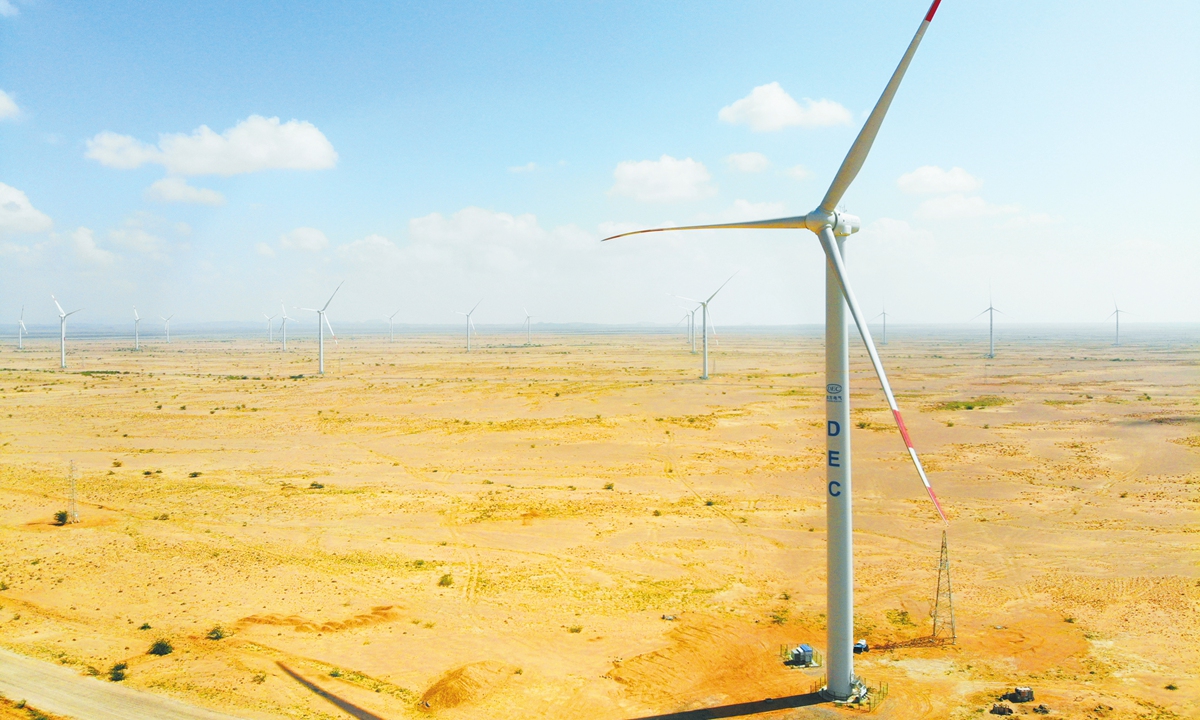BRICS nations eye ‘blue ocean’ in green cooperation as ties deepen during highly-watched summit

The Ayisha II Wind Power Project in Ethiopia, designed and constructed by the Northwest Electric Power Design Institute. (Photo: Courtesy of Northwest Electric Power Design Institute)
In Northern Cape, South Africa, the 100-megawatt Redstone concentrated solar thermal power plant, one of the largest renewable energy projects in the country built by a Chinese company, was successfully connected to the grid in mid-September.
Once fully operational, it will provide around 480 gigawatt-hours of clean electricity each year, serving over 200,000 households and helping to alleviate power shortages while reducing reliance on fossil fuels in the country.
The Ayisha II Wind Power Project in Ethiopia, designed and built by Chinese companies, now stands as the nation's largest in terms of both single-unit capacity and total installed power, serving as another shining example of green energy cooperation within the BRICS framework.
The project, competed in June 2022, delivers an annual output of 440 million kilowatt-hours of clean energy, significantly bolstering the development of local economy and enhance the living standards of local residents, the project's design company Northwest Electric Power Design Institute of China Power Engineering Consulting Group told the Global Times on Thursday.
"We are very optimistic about the prospects for cooperation with the BRICS nations," said Fan Tao, general manager of the International Engineering Company of Northwest Electric Power Design Institute Co, China Power Engineering Consulting Group, anticipating a rise in joint ventures and investment opportunities within BRICS countries, particularly in infrastructure and the clean energy sector as ties among BRICS countries deepen.
Win-win sustainable ties
The rapid expansion of clean energy ties between China and South Africa as well as Ethiopia reflects a broader trend toward green and low-carbon cooperation among BRICS nations, experts and industry insiders said.
BRICS countries have made substantial achievements in the energy sector during the past few years with renewable energy emerging as a focus of cooperation, according to media reports.
The BRICS Forum on Partnership on New Industrial Revolution 2024, held in Xiamen, East China's Fujian Province, in September, issued an initiative promising to expand pragmatic cooperation in sectors such as photovoltaics, wind power equipment, and new energy vehicles, accelerating the green transformation of industries.
"The BRICS countries are fundamentally transforming the global energy landscape, challenging established development paradigms and committing to ambitious sustainability targets," J. Renato Peneluppi Jr., a Brazilian professor specializing in public administration and energy transition policies at the China campus of the University of Worcester, told the Global Times on Thursday.
By the end of this year, these countries are set to achieve a milestone: the share of clean energy will surpass 50 percent of their energy mix driven by the rapid growth of clean sources and a decline in fossil fuels development in China and its peers, Peneluppi said citing a recent study from an international industry research institution.
"China's energy cooperation with other BRICS countries has achieved significant success. While traditional energy has dominated in the past, cooperation in renewable energy is now steadily increasing," Lin Boqiang, director of the China Center for Energy Economics Research at Xiamen University, told the Global Times.
Data released in September from the Brazil-China Business Council showed that in 2023, Chinese investments reached $1.73, up by 33 percent year-on-year, and 39 percent of the total flowed into Brazil's power sector, particularly green sectors such as wind, solar, and hydroelectric power.
Green ties
Following last year's expansion, the BRICS grouping now represents approximately 30 percent of global GDP, nearly half of the world's population, and one-fifth of global trade.
Given the growing energy demand driven by such a large combined population, the 16th BRICS Summit is poised to elevate South-South cooperation amid increasing global challenges, and pave the way for expanded green ties among member nations, experts said.
Most BRICS countries have strong growth potential, particularly in renewable energy and grid development, Zhong Xiaotao, senior manager of the International Business Department, China Southern Power Grid Company, told the Global Times.
As one of China's leading power companies, China Southern Power Grid has been actively involved in the global energy transition and is strengthening cooperation with BRICS nations such as Brazil, which has a relatively mature clean energy market.
Over the past decade, China has been rapidly building a clean, low-carbon, safe, and efficient energy system driven by high-quality development, and has achieved notable success.
China has established the world's largest carbon emissions trading market, covering around 5.1 billion tons of carbon dioxide annually and aiming for clean and high-quality growth.
Meanwhile, Chinese firms are increasing investments in BRICS countries' decarbonization efforts to forge a greener global community as economic ties strengthen and business environments improve.
Fan highlighted that the company is eager to share its cutting-edge technology, expertise, and resources with local firms in BRICS nations to move toward a brighter, greener future together under the BRICS framework.
China's leadership in technology and strong production capability in green sectors make it well-positioned to collaborate with BRICS, noted Lin.
Chinese enterprises have world-class expertise in clean energy development and grid integration, and they can help accelerate green transitions while building a new pattern of regional energy security, Zhong said.
Photos
Related Stories
- China ready to advance greater BRICS cooperation with all members: spokesperson
- Xi urges "BRICS Plus" to pursue common security and development, harmony among civilizations
- Xi advocates high-quality development of greater BRICS cooperation at milestone summit
- BRICS charts path at milestone summit, Xi offers five suggestions
- Interview: Russia, China to strengthen BRICS cooperation -- Russian deputy foreign minister
Copyright © 2024 People's Daily Online. All Rights Reserved.









